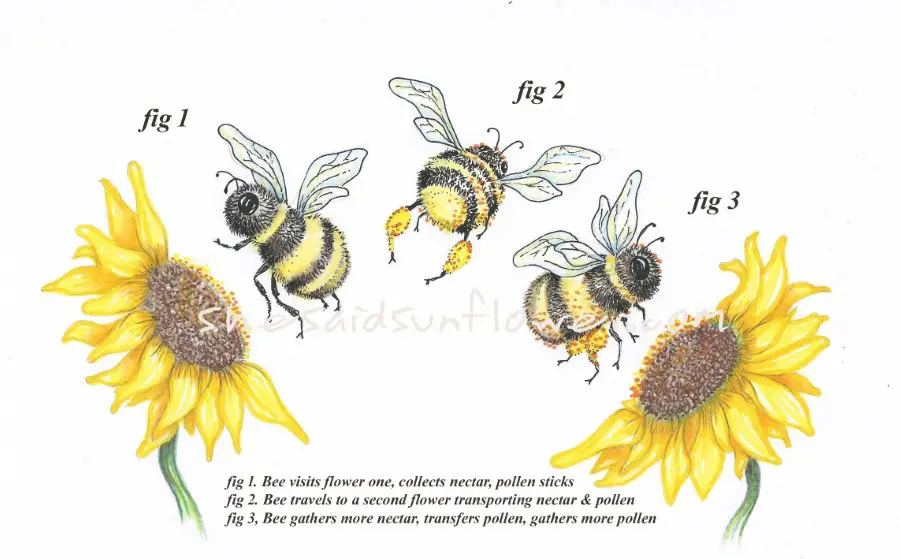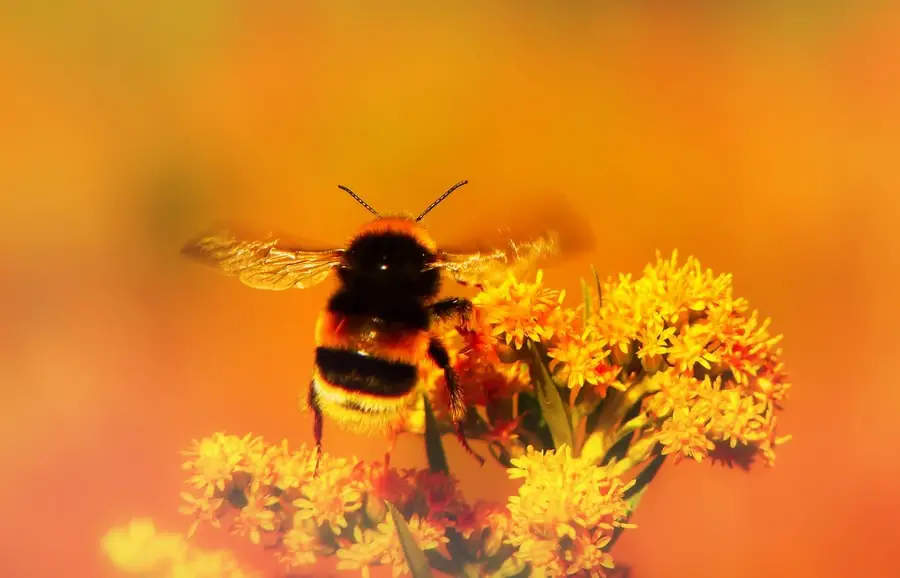The glorious blooms of sunflowers are such a big part of my summer, and bees are a big part of my sunflowers. And being pollinated is a big part in a sunflowers life cycle.
I love hearing the humble bumble buzzing around, because I know it means the big beautiful sunflowers I have grown are nourishing the wildlife, and in turn, they are pollinating my flowers to ensure a bountiful supply of seeds to sow in my garden for the following year.
And this is the main goal of the sunflower, to produce seeds.
So, How do sunflowers pollinate? There are two basic types of pollination. Cross-pollination and self-pollination. Sunflowers use both. Mainly performed by bees, as well as butterflies, moths, and beetles. When searching for nectar, the bees get covered in pollen, which they transfer to other sunflowers. This activates pollination.
The brightly colored petals of the sunflower and the warmth of the daily sun entices the pollinators to the nourishing nectar. The bees then get covered in pollen, then they move that pollen from flower to flower, pollinating as they go along.
Pollination can from the same sunflower or another sunflower, this is self and cross-pollination and this way the sunflower guarantees the production of seeds.
In the case of a lack of pollinators, the sunflower has evolved a mechanism to ensure its own pollination.
This is a fascinating pollination technique that the sunflower uses to stay alive, and one we will discuss
So now we know what types of pollination the sunflower uses, let’s delve into what pollination is, how our sunflower uses these types of pollination, and how the evolved mysterious mechanism works, to ensure the sunflowers own survival.
What Is Pollination?
Pollination is the main objective in a flowering plants life. It activates fertilization and ensures the production of seeds.

Fig 1. A Bee visits a sunflower to collect nectar. It brushes against the pollen which attached to its body.
Fig 2. The Bee then, laden with pollen and nectar, travels to another flower.
Fig 3. Transfer of pollen is complete when the Bee lands on a second flower.
The pollen, from the sunflower, is transported, by a variety of mediums, to another flower by a pollinator, also known as a pollination agent.
The pollen then settles on the female reproductive part of the flower thus activating fertilization. Now we know what pollination is, let’s get an understanding of how our sunflower is constructed for pollination, and further explore the different types of pollination, and how these work.
The Biology of a Sunflower
Here’s an interesting fact.
“The sunflower head is not just one flower, amazingly it is an array of flowers within one flower. This is known as Inflorescence, which actually means many flowers within a flower.”
The outer yellow petals are called the ray florets, these ray florets, along with the lovely smell of the warm nectar, attract bees into the large brown center disc. Hidden in this brown disc are many smaller flowers called disc florets. Each one of these disc florets has the ability to produce a seed.
Now let’s take a closer look at these disc florets, and where the process of pollination occurs.
The pollen particles, on the male part of the sunflower, the anthers, are transferred onto the female part of the flower, the stigma.
The pollen on the stigma starts to germinate and travel down the pollen tube into the plants’ ovary, where the ovule, or egg starts to fertilize and Develop a seed. Sunflowers have many disc florets and each one of these has the potential of producing a seed.
Self Pollination
Bees are attracted to the disc florets of our sunflower. This is where they drink the lovely, sun-warmed nectar. In turn, pollen sticks to the bees furry bodies. The bees then transfer that pollen within the same flower by visiting another disc floret. this is called Self Pollination or Autogamy
If our sunflower has multiple blooms on the same plant, and the bees visit these blooms, this is also Self-Pollination.
The Evolved Self Pollination Mechanism in Sunflowers
In the rare event that our sunflower disc florets do not get visited by pollinators, or finds itself in isolation, it has evolved a special mechanism, within itself to ensure its survival for the growth of seeds. This is called Homogamy.
Homogamy in Flowers
This is whenthe stigma curls itself around to make contact with its own pollen-covered anthers. This activates pollination within itself which starts the fertilization process and results in a seed.
The Disadvantages of Homogamy
This method could result in the seeds being weaker or deformed. This may result in the seeds not growing at all or a future plant being deformed which may not produce seeds itself.
The Advantage of Homogamy
This method could give our sunflower the chance to carry on its legacy, and in doing so it might get stronger the following year by Cross Pollination.
Which brings us nicely on to our next type of pollination.
Cross Pollination in Sunflowers
Bees are attracted to the nourishing nectar in the disc florets of our sunflower. They go in for the tasty nectar and in doing so get their furry bodies covered in pollen from the anthers of the sunflower.
The bee then flies across to another sunflower and transfers the pollen to the stigma of that sunflower. This is called Cross Pollination
Cross Pollination can occur within sunflowers of different varieties too, but sunflowers cannot activate pollination with flowers of different species, such as a Rose or Lily.
The Disadvantages of Cross-Pollination
There are few, as even if our sunflower is in isolation, and there are visiting pollinators, the disc florets can be Cross Pollinated within the same flower to ensure seed production.
The Advantages of Cross-Pollination
The main advantage is that this method will ensure a healthy and greater quantity of sunflower seeds to carry on its legacy for the following year.
Now we know the main types of pollination, I’d like to mention a few other forms of pollination that help our sunflowers to leave a legacy, develop the evolution of varieties, elimination of bad characteristics and maintenance of a pure lineage of sunflower.
Transferable Pollination in Sunflowers
Although this is Cross Pollination, usually done by bees and insects, transferable pollination can happen by the wind blowing our sunflowers pollen from flower to flower.
Sunflowers pollen is usually quite heavy and sticky, so although this method can happen, it is unusual. This is called Emophily.
Animals and humans can transfer pollen too, by brushing up against our sunflowers.
Again this is unusual, but it can activate pollination. I suppose this can be called Accidental Pollination.
And that leads perfectly on to
Artificial Pollination, by Humans.
This is done by humans who intervene and purposely dust the pollen from one sunflower to another sunflower. Most often propagated by growers and gardeners to create a new variety of sunflower. They select the captivating, or yielding characteristics to cross-pollinate, this produces different variations.
Although, it’s worth noting that this process could take many generations of artificial pollination to produce the desired features. This is called Anthophilia. A common plant breeding technique.
The Importance of Pollination for Us and the Environment
As a reward to the pollinators, Our sunflowers produce food and shelter for animals, birds bees and insects. Throughout the world, pollination of sunflowers means a large yield in crops of seeds and oil for cooking, baking, health and beauty products for people

In a Nutshell
The sunflower has been grown as a crop for over 2000 years. And now we know why, because of its guaranteed Pollination of and within itself.
And of course Cross Pollination. The sunflowers main pollinator is the bee, but other insects, animals, humans, and even the wind, help our sunflower to produce an abundance of seeds for agricultural and domestic reasons.
Final Thoughts
I’m always amazed at how glorious my sunflowers look. But looks aren’t everything our sunflowers have to offer.
How it has evolved to Self Pollinate itself ensuring its own survival, is both fascinating and astounding to me.
Not only does our sunflowers give an abundance of nourishment to its pollinators, by way of tasty nectar for themselves and their offspring, our sunflowers also provides a safe place for egg laying and shelter.
The sunflower is beautiful, a merit to our gardens and a huge contributor to the environment. I both admire My Sunflowers and regard them with high esteem.
Related Questions
How Do Sunflowers Reproduce? The term ‘reproduce’ may seem like a different subject altogether. Simply put, the act of sunflower reproduction is known as pollination. This can take various forms such as Cross-Pollination and Self-Pollination
Pollination Agents This is a wider topic and concerns the many types of insects and birds that may visit sunflowers. To summarize, the main insects that regularly pollinate flowers are bees. Other contributors are moths, butterflies, birds, and bats.
Do All Sunflowers Produce Seeds? Not all Sunflowers produce seeds. A number of varieties have been cultivated to produce hybrid versions, without seeds. These varieties are mainly used as show flowers, indoor flower arrangements and for use indoors without pollen to reduce the risk of aggravating pollen allergies.
All illustrations by Pamela-Anne, and are the property of shesaidsunflower.com

